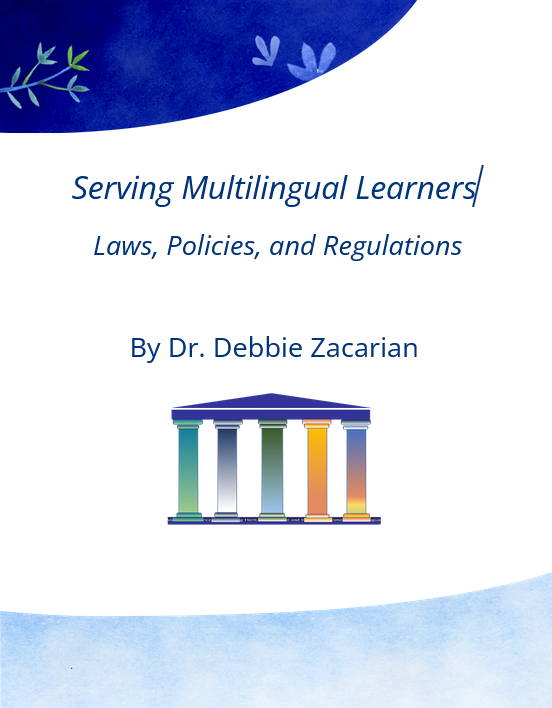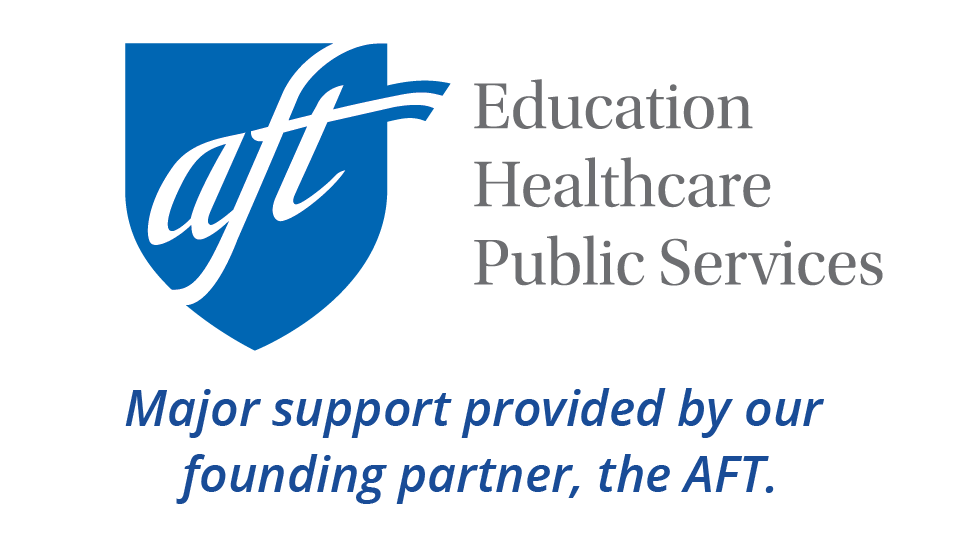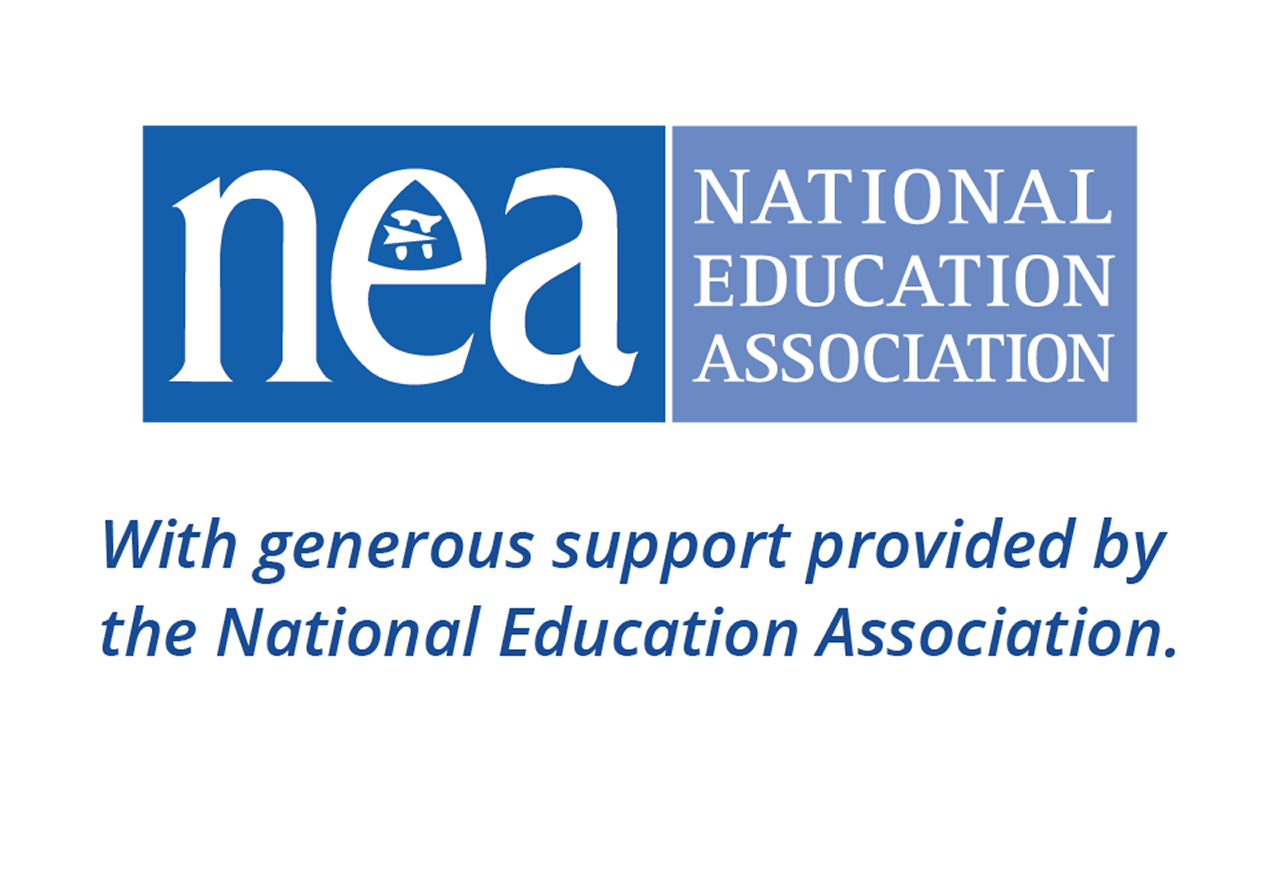The sixth key topic of the Dear Colleague Letter focuses on identifying and serving MLs with disabilities. According to the Dear Colleague Letter, schools and state education agencies must "ensure that MLs with Disabilities Under the Individuals with Disabilities Act [IDEA] or Section 504 are evaluated in a timely and appropriate manner for special education and disability-related services and that their language needs are considered in evaluations and delivery of services" (U.S. Departments of Justice and Education, 2015, p. 8).
A Note on Terminology
The strengths-based term multilingual learner is used throughout this document to recognize and value students' existing language abilities and highlight what they know. Keep in mind that states may use different terms and that many federal documents use the terms "English learner" and "Limited English Proficient students."
See the federal definition of a multilingual learner in Who Are Multilingual Learners?
Guiding Questions
Download this guide
 This guide is also available in a PDF version for download and printing.
This guide is also available in a PDF version for download and printing.
- What is the Individuals with Disabilities Education Act [IDEA]?
- What are some trends of MLs and Special Education?
- In our work identifying and serving MLs with disabilities:
- Why is it important to evaluate the effectiveness of language assistance programming?
- Why use a team approach?
- What steps must be taken with parents and guardians?
- What action steps should be taken to assess a district’s procedure for identification of and services for MLs with learning disabilities?
Schools’ Legal Obligations Regarding MLs with Disabilities
It is important to note that all SEAs and school districts are legally obligated to do the following according to the Dear Colleague Letter:
- Identify MLs in a timely manner
- Consider the English language proficiency level of all MLs in determining the appropriate assessments and other evaluation materials used
- Not determine students have a disability because of their limited English language proficiency
- Provide EL students with disabilities with both the language assistance and disability-related services they are entitled to under Federal law
- Inform parent/guardian of a ML with an individualized education program (IEP) how the language instruction education program meets the objectives of the child's IEP (p. 24-25).
Individuals with Disabilities Education Act [IDEA]
In 1975, Congress enacted the Individuals with Disabilities Education Act [IDEA], which addresses the rights and educational needs of children with disabilities. The law has been amended several times, most recently in 2004 and Every Student Succeeds Act of 2015. IDEA spans students' education from birth to age 21.
Individuals with Disabilities Education Act [IDEA] |
|---|
Under IDEA,§1401 Section 3: (A) In general, the term "child with a disability" means a child — (i) with intellectual disabilities, hearing impairments (including deafness), speech or language impairments, visual impairments (including blindness), serious emotional disturbance (referred to in this chapter as "emotional disturbance"), orthopedic impairments, autism, traumatic brain injury, other health impairments, or specific learning disabilities; and (ii) who, by reason thereof, needs special education and related services. (B) Child[ren] aged 3 through 9 The term "child with a disability" for a child aged 3 through 9 (or any subset of that age range, including ages 3 through 5), may, at the discretion of the State and the local educational agency, include a child— (i) experiencing developmental delays, as defined by the State and as measured by appropriate diagnostic instruments and procedures, in one or more of the following areas: physical development; cognitive development; communication development; social or emotional development; or adaptive development; and (ii) who, by reason thereof, needs special education and related services. |
MLs and Special Education: Common Questions
What are some trends of MLs and Special Education?
The U.S. Department of Education Office of Special Education and Rehabilitation Services (April 2022) posted some facts about MLs, which are important for all of us to consider:
- "The number of students with disabilities that are MLs in the U.S. grew by close to 30% between school years 2012 to 2020."
- MLs with disabilities "were more likely to drop out of school, less likely to graduate with a highs school diploma, and more likely to receive a certificate as compared to all students served under IDEA, Part B."
- MLs with disabilities "were less likely to be served inside the regular class 80% more of the day as compared to all school-aged students served on IDEA, Part B."
- MLs "were more likely to be identified with a specific learning disability or speech or language impairment, autism, or emotional disturbance as compared to all students served under IDEA, Part B."
In addition to the trends discussed by the U.S. Department of Education, MLs being over-identified as having disabilities when they don't is a chronic issue that needs our attention. Two of the major reasons for this outcome are that MLs may be referred for a special education evaluation when:
- They do not seem to be making the same academic progress as their English-fluent peers.
- They don't seem to be learning English rapidly.
Another chronic issue is MLs being under-identified. This happens when students who have disabilities are not referred for special education services. It happens when schools fear that they might be referring MLs too quickly. This "wait till the student fails" and "stall for time" approach can prevent us from identifying MLs with disabilities in a timely manner.
It is also possible for schools or districts to over-correct in one direction or the other, especially if an over- or under-identification trend is identified. (See Dr. Zacarian speak on this topic in this related video clip.) That is why schools need procedures in place that offer a comprehensive view of each individual child and their progress. (See related resources below.)
Why is it important to evaluate the effectiveness of language assistance programming?
Every school district must demonstrate that its language assistance program is effective. This is done by gathering data to show that programming is based on the above-mentioned Castañeda v. Pickard federal regulations that programming is (1) based on sound educational research, (2) implemented with adequate commitment and resources, and (3) proven to be effective. Please refer to the following topics for more information:
- Language Assistance Programs for Multilingual Learners
- Evaluation of Language Assistance Programs: Serving Multilingual Learners
Additionally, a team of teachers, administrators, and specialists should periodically review and analyze data about the MLs who have been referred and evaluated for special education services. The action steps at the end of this section drawn from Zacarian (2023) are intended for this purpose. See more in these related videos.
Why use a team approach?
It is critical for schools serving MLs to use a team approach that includes students and families as well as staff, including bilingual, bicultural staff; classroom, ESL, subject matter, and special education teachers; reading specialists and speech and language pathologists; counselors; and family liaisons. It is also important that all who educate MLs and supervise those working with MLs have training to work with multilingual learners (Note: See our section on Staffing and Staff Preparation for more information.)
What steps must be taken with parents and guardians?
MLs' parents and guardians have the right to receive information from the school in a language that is meaningfully understood — including all information related to special education. Under the federal laws, they also have the right to meaningful participation and inclusion in evaluation decisions, procedures, and meetings — such as referrals, evaluations, and procedures related to special education. As importantly, parents, guardians, and MLs themselves can and do provide us with invaluable information when we create an open dialogue for this purpose.
Including Interpreters and Translators
Federal law requires providing interpreters (commonly referred to as translators) for meetings and written translations for parents and guardians who need them. To ensure full participation, it is helpful to confirm in advance who will attend the meetings and whether an interpreter is needed.
Additionally, the language of special education — including terms, idiomatic expressions, and acronyms such as Ed Plan, Team Meeting, Child Study Team, IEP, 504, and SLP — requires educators, parents, guardians, and multilingual interpreters and translators to be knowledgeable and capable of having meaningful communication throughout the process of identifying and supporting a child with disabilities.
As such, it is imperative that school personnel employ interpreters and translators who:
- Are proficient in English and the primary language(s) of parents and guardians.
- Are familiar with a school's programming, policies, and practices related to:
a. general school programming,
b. language education programming, and
c. special education.
It is also crucial to provide interpreters and translators with ongoing professional development to ensure they have an up-to-date understanding of the school's general education, language education, and special education programs, as well as the technical language associated with these. This understanding enables them to help parents and guardians of MLs understand their child's needs, support their child effectively, and make informed decisions on their child's behalf.
Note: See the following articles for building, training, and sustaining an effective cadre of interpreters and translators. Each features insights from Dr. Jennifer Love, Director of Language Access Services for Prince George's County School District in Maryland:
- Equity Through Language Access: Best Practices for Collaborating with Interpreters
- Building Interpreter and Translator Networks
Proactive steps that schools can take to partner with families, interpreters, and translators include the following:
- Collaborating with families about scheduling meetings and setting meeting times
- Ensuring that families, interpreters, and translators meaningfully understand all of the information discussed, as well as any proposed plans or solutions
- Ensuring that interpreters and translators have training in interpreting and providing written translations about special education
- Collaborating closely with family liaisons, interpreters, and translators
- Allocating time for interpretation, as meetings with interpreters may take up to 50-100% longer
Note: Some families may hesitate to sign forms or agree to services for their children. This article by National Teacher of the Year Juliana Urtubey, provides some helpful considerations.
For more ideas and resources, see:
- Special Education and Your Child: FAQs for Multilingual Families (14 languages)
- Equity Through Language Access: Best Practices for Collaborating with Interpreters
- American Speech and Language Hearing Association on IDEA with Culturally and Linguistically Diverse Students
- Comparison of Language Differences Versus Disabilities (English Learner Toolkit, Chapter 6)
- Fact Sheet: Equal Access to Elementary and Secondary Education for Students Who Are English Learners with Disabilities (U.S. Department of Education)
- Video Collection: Special Education and English Language Learners
Case Study: Language Access |
|---|
Dr. Jennifer Love, Director of Language Access for Prince George's County Public Schools in Maryland, brings these ideas to life. She states that the Dear Colleague Letter helped solidify the translation arm of the district. It has moved well beyond providing interpreters at meetings to include systematic communication from e-blasts, outreach videos, and social media in dozens of languages. As importantly, it includes continuous professional growth and training to better ensure their success in partnering with families. Dr. Love tells us that her district has moved from language access as an add-on to fully embracing multilingual communication. She also shares that one of the district's biggest commitments is to nurture the growth and leadership of their translation teams. The professional growth steps that they take, and their evaluation of these steps, are vital for ensuring that families are well informed about their child's programming and performance in school and are partners with us (Zacarian, 2023, pp. 121-122). Discussion QuestionDrawing from the federal laws and regulations and what Dr. Love shared, what steps might you take to ensure that parents and guardians have full access to and participation in the referral, identification, and special education services offered in your context? |
Tools for Educators
These tools can support educators in their work related to identifying and serving MLs with disabilities. A printable version of these tools is available in the PDF version of this guide.
Analysis of ML Population & Special Education Referrals | |
|---|---|
The following action steps, drawn from Zacarian (2023, pp. 166-167), are intended to help in assessing the identification of and services for MLs with learning disabilities. | |
Total number of identified MLs in the school |
|
Total number of MLs who were referred during this school year for a special education evaluation in the school |
|
Total percentage of MLs referred for a special education evaluation during this school year |
|
Is the proportion of MLs who have been referred the same as the proportion of the general population of students who have been referred? | Yes ☐ No ☐ |
If no, what is the difference noted? |
|
Is the proportion of MLs who have been identified as having disabilities the same as the proportion of the general population of students who have been identified? | Yes ☐ No ☐
|
If no, describe the differences. |
|
Are there commonalities among the languages spoken by MLs and the reasons for referral or diagnosis of disability? | Yes ☐ No ☐
|
If yes, what is the commonality? |
|
Action Steps: Reasons for ML Special Education Referrals | |
|---|---|
The reasons, by total number of occurrences, that MLs were referred for a special education evaluation this year follow below. | |
_______ Autism _______ Cognitive Disability _______ Deaf-Blindness _______ Deafness _______ Emotional Disturbance _______ Hearing Impairment _______ Multiple Disabilities _______ Orthopedic Impairment _______ Other Health Impairment, Including ADHD _______ Specific Learning Disability _______ Speech/Language Impairment _______ Traumatic Brain Injury _______ Visual Impairment, Including Blindness | |
The most common reason that MLs were referred for a special education evaluation this year is: |
|
Anecdotally, describe any additional commonalities among the MLs who were referred (e.g., interrupted formal education). |
|
Action Steps: Staffing and Assessments for MLs with Disabilities | |
|---|---|
Teachers and Specialists
Assessments
|
Action Steps: Identifying and Serving MLs With Learning Disabilities | |
|---|---|
*Language assistance programming for MLs must be based on sound educational research, implemented with adequate commitment and resources, and evaluated and proved to be effective. **This includes general education and English language development instruction for MLs. Note: Please refer to a federal lawsuit that was filed showing a lack of involvement with families around special education. | |
Copyright© 2023 by Corwin. All rights reserved. Adapted from Transforming Schools for Multilingual Learners: A Comprehensive Guide for Educators, Second Edition by Debbie Zacarian. Thousand Oaks, CA: Corwin, www.corwin.com. Posted with permission from Corwin Press.










Add new comment